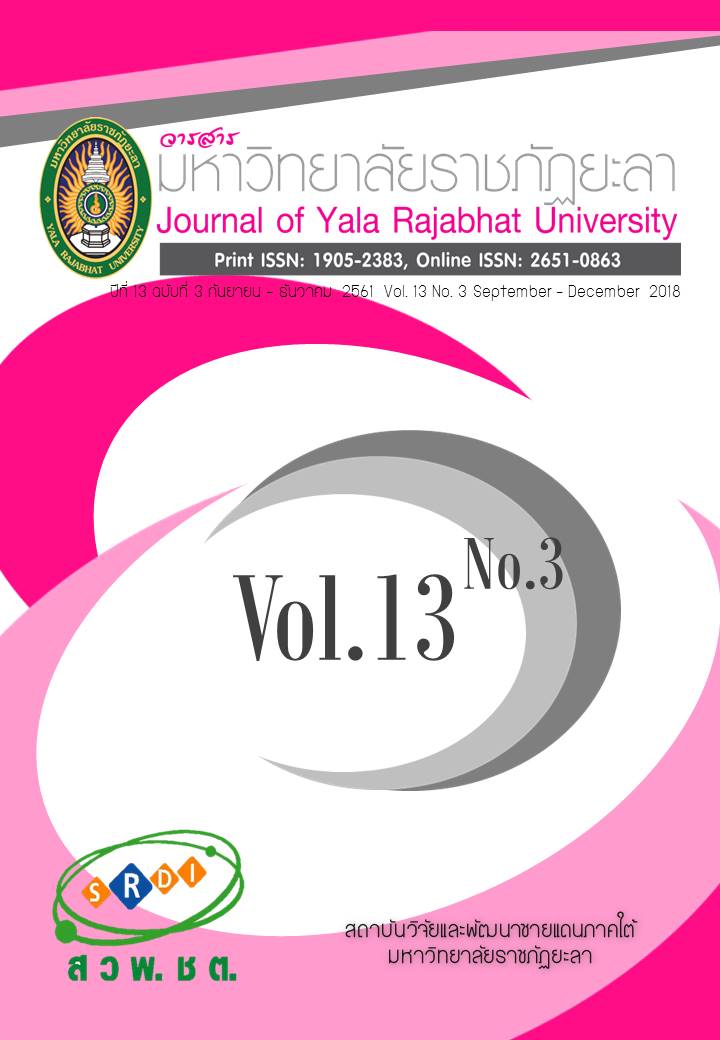Development of Evaluation Instrument for teaching efficiency of 21st Century under Primary Educational Service Area in Three Southern Border Provinces of Thailand
Main Article Content
Abstract
The objectives of this study were 1) to develop and evaluate the 21st century teaching efficiency tool for teachers the jurisdiction of primary education in the three southern border provinces. In addition, 2) the local norm of teachers in three southern border provinces was also created. The samples consisted of 390 teachers selected by random sampling from the jurisdiction of primary education in the three southern border provinces. Based on developmental research, the 21st century teaching efficiency tool was constructed in form of 5 – level Likert scale, and consisted of 8 major factors as follow: content, computer integration, constructivism, connectivity, collaboration, communication, creativity and caring. Results showed that the caring factor was at the highest level and that of connectivity and constructionism factors was at the lowest level. It is recommended that connectivity and constructionism has to be upgraded seriously to meet the need of the 21st century teaching efficiency in three southern border provinces.
Article Details
Copyright Notice articles, information, images, etc. was published in this Journal of Yala Rajabhat University is a copyright of the journal Yala Rajabhat University. If any person or deparment wants to bring all or part of it for publish or take any action. Authorization is required in written form from the Journal of Yala Rajabhat University only.
References
2. Greenstein, L. (2012). Assessing 21st Century Skills Aguide to evaluating masteryand authentic learning. United kingdom: 1 Oliver’s yard.
3. Jamornmarn, A. (2002). Exams: Creating and Developing. Bangkok: Funny Publishing. (in Thai)
4. Laohajaratsang, T. (2016). Teacher [Online]. Retrieved January 22, 2016, from: https://thanompo.edu.cmu.ac.th/load/journal/50-51/Cteachers.pdf. (in Thai)
5. Mihaela Voinea, T. P. (2014). Teachers’ professional identity in the 21st century Romania. Procedia - Social and Behavioral Sciences, 128, 361 – 365.
6. Nilphan, M., Paivitayasiritham, C., Wanichwattanaworachai, S. & Songserm, A. (2015). Evaluation of Core Curriculum Core Curriculum in 2008. Fine Arts Education Research Journal, 7(1), 26-41. (in Thai)
7. Office of the Education Council. (2014a). An Analysis of Thai Studies in the 21st Century. Research Journal of Education, 2(4), 1-3. (in Thai)
8. Office of the Education Council. (2014b). Pilot Research to Develop Teacher Production Curriculum for the 21st Century. Research Journal of Education, 2(2), 33-44. (in Thai)
9. Panich, V. (2012). The way to learn for student in 21st . Bangkok: Sodsri – Saridwong foundation. (in Thai)
10. Saiyod, L., & Saiyod, A. (2000). The Evaluation Techniqs. Bangkok: Suwiriyasarn. (in Thai)
11. Songpan, W., Dechpichai, W. & Krahomwong, R. (2017). The Development of School Administrative Model for achieving Internal Quality Assurance of Secondary Schools in South Andaman Area. Journal of Yala Rajabhat University, 12(1), 117-130. (in Thai)
12. Teachers Council. (2013). Teachers Council [Online]. Retrieved November 30, 2016, from:
https://www.ksp.or.th. (in Thai)
13. Wangsrikoon, A. (2014). Thailand Educational in 21st Century: Productive and Development. Journal Pibulsongkran University, 8(1), 1 - 17. (in Thai)


